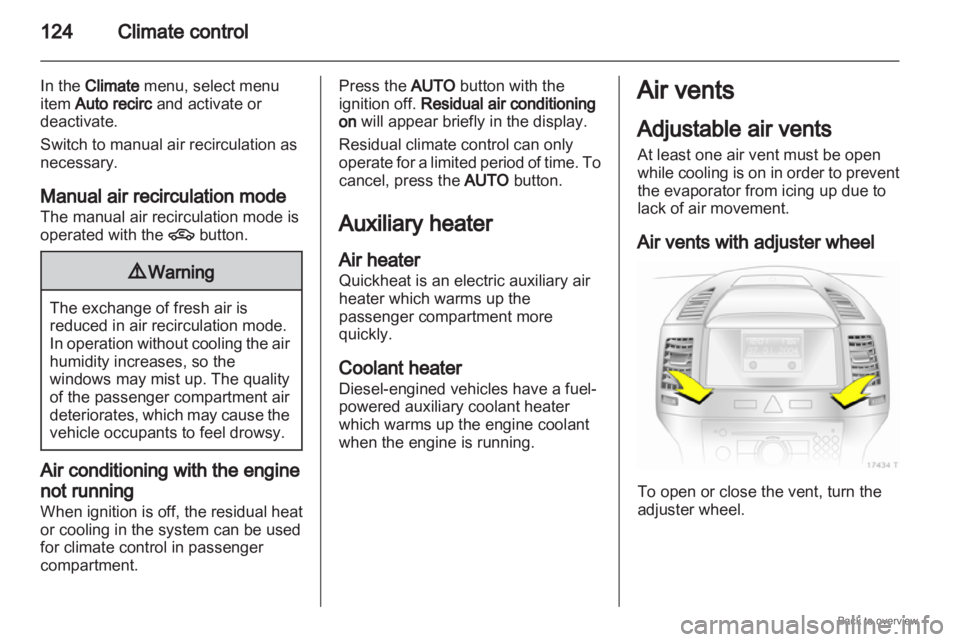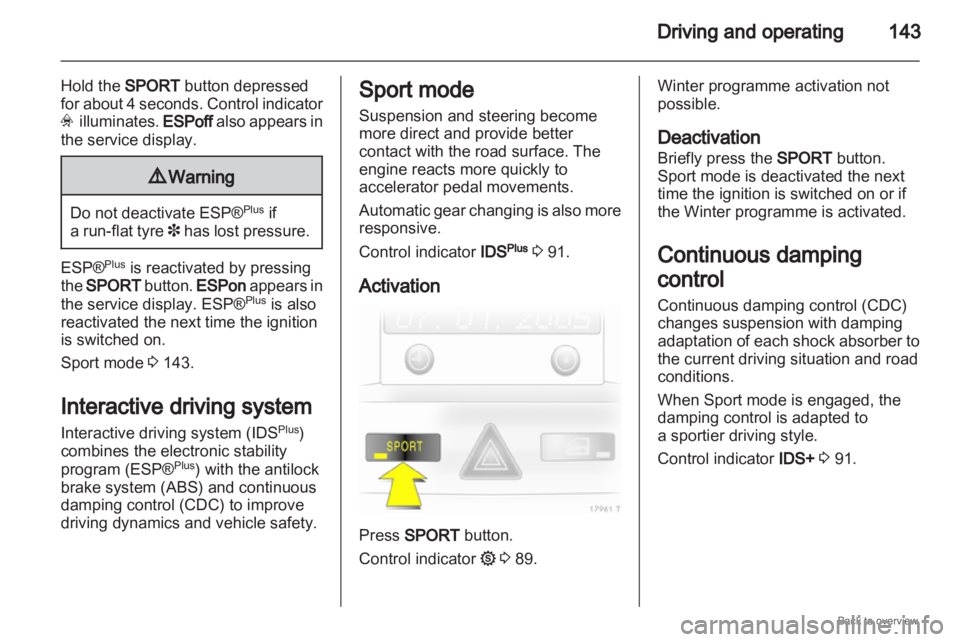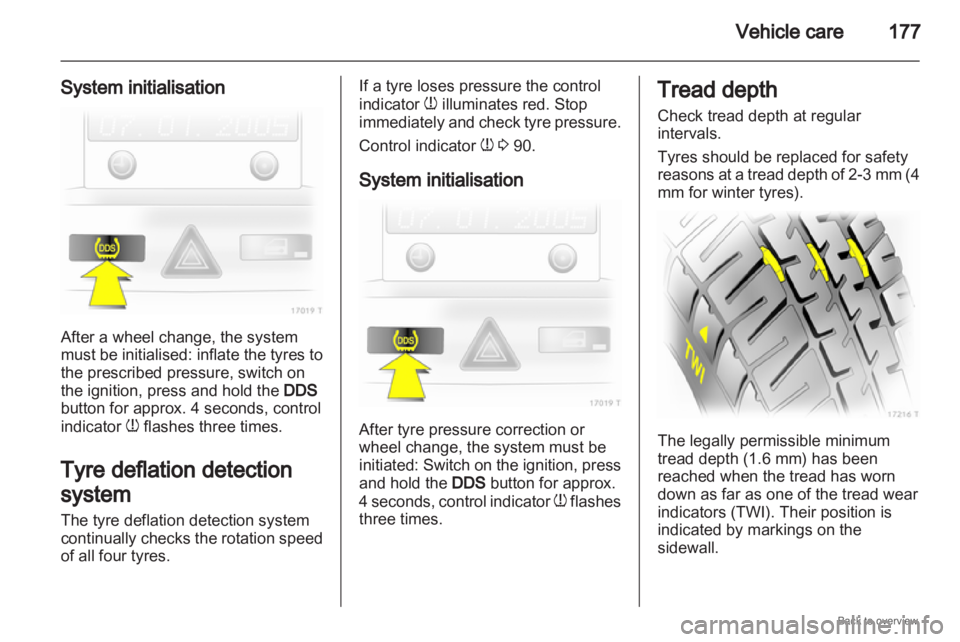Page 124 of 228

124
Climate control
In the Climate menu, select menu
item Auto recirc and activate or
deactivate.
Switch to manual air recirculation as
necessary.
Manual air recirculation mode
The manual air recirculation mode is
operated with the 4 button. 9
Warning The exchange of fresh air is
reduced in air recirculation mode.
In
operation without cooling the air
humidity increases, so the
windows may mist up. The quality
of the passenger compartment air
deteriorates, which may cause the
vehicle occupants to feel drowsy. Air conditioning with the engine
not running
When
ignition is off, the residual heat
or cooling in the system can be used
for climate control in passenger
compartment. Press the AUTO button with the
ignition off. Residual air conditioning
on will appear briefly in the display.
Residual climate control can only
operate
for a limited period of time. To
cancel, press the AUTO button.
Auxiliary heater
Air heater
Quickheat is an electric auxiliary air
heater which warms up the
passenger compartment more
quickly.
Coolant heater
Diesel-engined vehicles have a fuel-
powered auxiliary coolant heater
which warms up the engine coolant
when the engine is running. Air vents
Adjustable air vents
At least one air vent must be open
while
cooling is on in order to prevent
the evaporator from icing up due to
lack of air movement.
Air vents with adjuster wheel To open or close the vent, turn the
adjuster wheel.
Page 143 of 228

Driving and operating
143
Hold the SPORT button depressed
for about 4 seconds. Control indicator
v illuminates. ESPoff also appears in
the service display. 9
Warning Do not deactivate ESP®
Plus
if
a
run-flat tyre 3 has lost pressure.ESP®
Plus
is reactivated by pressing
the SPORT
button. ESPon appears in
the service display. ESP® Plus
is also
reactivated the next time the ignition
is switched on.
Sport mode 3 143.
Interactive driving system
Interactive driving system (IDS Plus
)
combines the electronic stability
program (ESP® Plus
) with the antilock
brake system (ABS) and continuous
damping control (CDC) to improve
driving dynamics and vehicle safety. Sport mode
Suspension and steering become
more direct and provide better
contact with the road surface. The
engine reacts more quickly to
accelerator pedal movements.
Automatic
gear changing is also more
responsive.
Control indicator IDSPlus
3 91.
Activation Press SPORT button.
Control indicator
1 3 89. Winter programme activation not
possible.
Deactivation
Briefly press the SPORT button.
Sport mode is deactivated the next
time the ignition is switched on or if
the Winter programme is activated.
Continuous damping
control
Continuous damping control (CDC)
changes suspension with damping
adaptation
of each shock absorber to
the current driving situation and road
conditions.
When Sport mode is engaged, the
damping control is adapted to
a sportier driving style.
Control indicator IDS+ 3 91.
Page 154 of 228

154
Vehicle care
Vehicle care
General Information ...................154
Vehicle checks ........................... 155
Bulb replacement .......................160
Electrical system ........................167
Vehicle tools .............................. 173
Wheels and tyres .......................174
Jump starting ............................. 185
Towing ....................................... 187
Appearance care .......................189 General Information
Accessories and vehicle
modifications
We
recommend to use Genuine Parts
and Accessories and factory
approved parts specific for your
vehicle type. We cannot assess or
guarantee for other products - even if
they have a regulatory or otherwise
granted approval.
Do not make any modifications to the
electrical system, e. g. changes of
electronic control units (chip tuning).
Vehicle storage
Storage for a long period of time
Following must be done if the vehicle
should be stored for several months:
■ Wash and wax the vehicle.
■ Have the wax in the engine compartment and underbody
checked.
■ Clean and preserve rubber seals.
■ Change engine oil. ■ Drain washer fluid reservoir.
■
Check coolant anti-freeze andcorrosion protection.
■ Adjust tyre pressure to the value specified for full load.
■ Park vehicle in dry, well ventilated place. Engage first or reverse gear
or set selector lever to P. Prevent
the vehicle from rolling.
■ Do not apply hand brake.
■ Open bonnet, close all doors and lock the vehicle.
■ Disconnect the clamp from the negative terminal of the vehicle
battery. Beware that all systems are
not functional, e.g. anti-theft alarm
system.
Putting back into operation
Following must be done if the vehicle
is putting back into operation: ■ Connect the clamp to the negative terminal of the vehicle battery.
Activate the electronic of the power
windows.
■ Check tyre pressure.
■ Fill up the washer fluid reservoir.
Page 177 of 228

Vehicle care
177
System initialisation After a wheel change, the system
must
be initialised: inflate the tyres to
the prescribed pressure, switch on
the ignition, press and hold the DDS
button for approx. 4 seconds, control
indicator w flashes three times.
Tyre deflation detection
system
The tyre deflation detection system
continually checks the rotation speed
of all four tyres. If a tyre loses pressure the control
indicator
w illuminates red. Stop
immediately
and check tyre pressure.
Control indicator w 3 90.
System initialisation After tyre pressure correction or
wheel change, the system must be
initiated:
Switch on the ignition, press
and hold the DDS button for approx.
4 seconds, control indicator w flashes
three times. Tread depth
Check tread depth at regular
intervals.
Tyres should be replaced for safety
reasons
at a tread depth of 2-3 mm (4
mm for winter tyres). The legally permissible minimum
tread depth (1.6 mm) has been
reached when the tread has worn
down as far as one of the tread wear
indicators (TWI). Their position is
indicated by markings on the
sidewall.